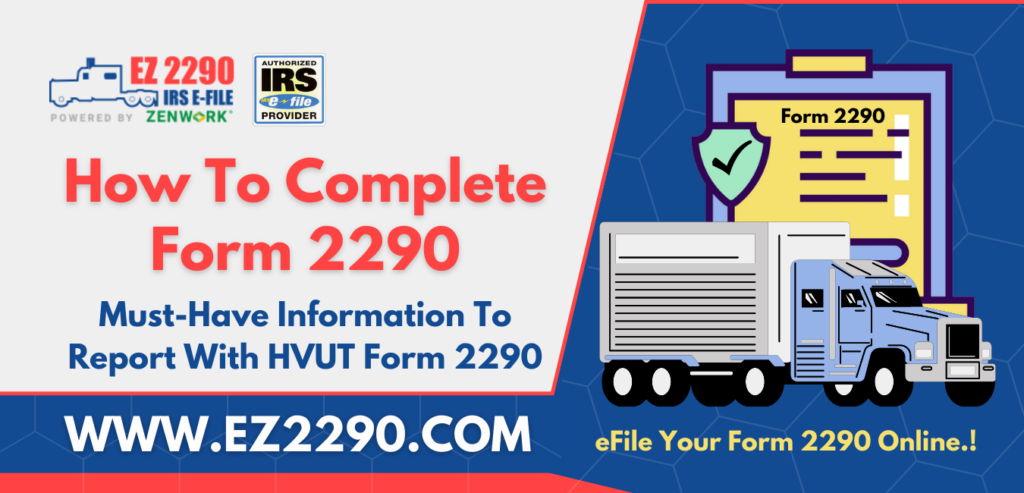
Here’s a list of the information you need to complete Form 2290 reporting.
Businesses file 2290 forms to report certain truck tax information to the IRS.
If you’re a fleet owner or a small truck business owner, you just know how important 2290 filings are for your compliance journey.
When you don’t file your HVUT tax forms, your business receives ‘failure to file’ notices from the IRS.
And the penalty assessments usually add up to a huge amount when you consider the interest they accrue in just a few weeks.
This is why thousands of business owners prioritize their truck tax information filings and look for various guides and instructions pertaining to 2290 filings.
To make your life easier, we have put together a list of all the information you will need to prepare, complete, validate, and eFile your 2290 returns.
This list is a generic one, and includes all the necessary details you will need if you’re filing new 2290 returns for the current filing period.
If you’re looking for specific information on 2290 Amendment or 2290 VIN Corrections, follow the guides linked below.
→ How To Do VIN Corrections: A Simple Guide For Beginners
→ How To Amend 2290 Returns: A Simple Guide For Beginners
Follow this checklist for a quick overview of 2290 filings.
And follow this guide to understand the significance of Form 2290 in HVUT compliance.
So, let’s get to the main theme of this discussion – the essential information you need to complete Form 2290.
Here’s the information you need to complete Form 2290
- Business name or ‘Doing Business As’ (DBA) name
- Address
- EIN
- Purpose of filing
- Gross weight of the vehicle
- Month of first use
- Mileage use limit
- Vehicle identification number
- Tax credit information
- Number of logging vehicles
- Number of non-logging vehicles
- Vehicle category
- Vehicle tax suspension details
Business name or doing business as (DBA) name
This is the registered name of your business and must be reported exactly the same to avoid name reporting errors. Make sure that the name of the business is the same as the legal name of the entity.
If you’re an owner-operator, make sure that the information is in accordance with your social security records and/or DMV documentation.
Address
This address is the legal address of your business. You will need to format the address according to the USPS records.
EIN
Employer Identification Number (EIN) or Taxpayer Identification Number (TIN) is the legal “code” assigned to your business by the IRS. You will need to enter this information to help the IRS track your business filings for all tax years as relevant to your case.
If you’re an individual, you will need to enter the social security number (this must be the same as your previous IRS filings unless notified by the IRS as incorrect).
Purpose of filing
Define the purpose of your 2290 filings.
If it’s a fresh filing for the current filing period, then you can just proceed to fill out the form with the relevant business information and move on.
However, if you’re filing for, say, VIN Correction or 2290 Amendment, then you will specifically need to select the relevant filing options in the top section of the 2290 return. Unless selected, the return will be treated as a regular filing and could possibly get rejected.
Gross weight of the vehicle
The gross weight of the vehicle is the weight of the vehicle that is subject to HVUT taxes. If your heavy truck weighs more than 55,000 pounds, then it qualifies for HVUT.
Month of first use
The month of first use is an important element of the 2290 reporting regime. If the vehicle was first used in, say, April, then you’re required to file 2290 by the end of May of the same filing period.
Mileage use limit
A commercial (non-agricultural) vehicle is allowed to utilize up to 5,000 miles without being taxed. And an agricultural vehicle is allowed to utilize up to 7,500 miles without being taxed. However, once the respective mileage exceeds the prescribed limits, the vehicle will be subject to HVUT tax.
Vehicle identification number
The vehicle identification number or VIN is a unique set of characters assigned to a vehicle for identification. Make sure to validate the VINs before you report them on Form 2290 to avoid incorrect 2290 reports.
The IRS usually doesn’t keep a track of VIN reports, so it’s your responsibility to report VINs accurately.
Tax credit information
If you’ve received a refund from the IRS through Form 8849, then you need to report the same on Form 2290. The refund received must be deducted from the total tax owed, and the product of that would be the final tax you will be required to pay to the IRS.
Number of logging vehicles
Logging vehicles are usually taxed less than regular heavy vehicles. So, make sure that you report the number of logging vehicles and their VINs accurately to avoid confusion.
Number of non-logging vehicles
Non-logging vehicles or vehicles exempt from logging are taxed at $100 (for 55,000 pounds) with an additional $22 for every 1000 pounds the vehicle adds to its gross taxable weight. Enter the correct figure on Form 2290 for accuracy.
Vehicle category
Vehicle categories are assigned to vehicles to define their tax suspension status, HVUT reporting status, mileage utility, and other compliance-related properties of vehicles.
For example, ‘Category W’ vehicles are suspended from taxes. You need not pay HVUT on tax-suspended vehicles, but you’re required to report the number of vehicles on Form 2290.
Vehicle tax suspension details
If a vehicle is driven for less than 5000 miles (for commercial vehicles) and 7500 miles (for agricultural vehicles), then the vehicle is suspended from taxes.
Report the correct category of the vehicle on Form 2290 to pay taxes on vehicles that qualify for HVUT.
Tax suspension details help reduce the tax burden on your small trucking business.
So, it’s important to maintain a master sheet with all the regulatory information of the vehicles. This further accelerates reporting accuracy.
eFile Form 2290 With EZ2290
Use the above checklist to gather all the required information for your 2290 filings and start preparing your 2290 forms with EZ2290.
EZ2290 is an IRS-authorized eFile provider, trusted by 10,000+ trucking companies across the U.S.
Join thousands of trucking businesses that use EZ2290 every month for convenient 2290 compliance experiences.
EZ2290 offers:
- Quick and easy bulk data import
- Real-time TIN matching
- Dynamic form completion
- Automatic HVUT tax calculations
- Secure & encrypted eFile transmissions
- Free 2290 VIN Corrections
- Free re-files for rejected returns
- Multiple online HVUT payment options for convenience
- Priority 2290 tax support
And much more.
Calculate HVUT For Free | eFile Form 2290 For 2022-2023 Tax Year






